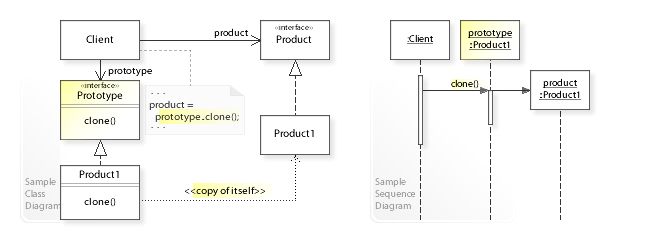原型模式(Prototype Pattern)
wiki:
类型: 创建型
何时使用: 当直接创建对象的代价比较大时,则采用这种模式
UML
原型设计模式解决了以下问题:
- 如何创建对象以便在运行时指定要创建的对象?
- 如何动态加载类的实例化
原型设计模式描述了如何解决这些问题:
- 定义一个
Prototype返回自身副本的对象。 - 通过复制
Prototype对象创建新对象。
原型模式的注意事项:
- 使用原型模式复制对象不会调用类的构造方法。
- 单例模式中,只要将构造方法的访问权限设置为private型,就可以实现单例。但是clone方法直接无视构造方法的权限,所以,单例模式与原型模式是冲突的,在使用时要特别注意。
浅拷贝: Object类的clone方法只会拷贝对象中的基本的数据类型,对于数组、容器对象、引用对象等都不会拷贝深拷贝: 将原型模式中的数组、容器对象、引用对象等另行拷贝- 因为是从内存中直接
原型模式实例
抽象原型角色
public abstract class Prototype implements Cloneable{
@Override
public Object clone() throws CloneNotSupportedException {
return super.clone();
}
}
具体原型角色
public class ConcretePrototype1 extends Prototype {
@Override
public Object clone() throws CloneNotSupportedException {
return super.clone();
}
}
public class ConcretePrototype2 extends Prototype {
private ArrayList list = new ArrayList();
/**
* 由于Clone不会调用构造函数,可用来查看差别
*/
public ConcretePrototype2() {
System.out.println("ConcretePrototype2 init...");
this.list.add("Hello World!");
}
public ArrayList getList() {
return list;
}
public void setList(ArrayList list) {
this.list = list;
}
@Override
public Object clone() throws CloneNotSupportedException {
ConcretePrototype2 clone = (ConcretePrototype2)super.clone();
// 深度拷贝
clone.setList((ArrayList) this.getList().clone());
return clone;
}
}
场景类
public class Client {
public static void main(String[] args) throws CloneNotSupportedException {
// 测试克隆
ConcretePrototype1 concretePrototype1 = new ConcretePrototype1();
System.out.println(concretePrototype1);
System.out.println(concretePrototype1.clone());
System.out.println();
ConcretePrototype2 concretePrototype2 = new ConcretePrototype2();
System.out.println(concretePrototype2);
final ConcretePrototype2 clone = (ConcretePrototype2)concretePrototype2.clone();
System.out.println(clone);
System.out.println(concretePrototype2.getList());
System.out.println(clone.getList());
// 测试性能
System.out.println();
int count = 10000;
long startTmie = System.currentTimeMillis();
for (int i = 0;i带Prototype Manager的原型模式(登记形式的原型模型)
- 从缓存(MAP)中获取
- 可使用HashTable或者ConcurrentHashMap
- 如果使用HashMap需要考虑加锁,或者
Collections.synchronizeMap(hashMap);使其同步
UML
@startuml
class Client{
}
interface Prototype{
+ Prototype clone()
}
class ConcretePrototypeA{
- name:String
+ clone():Prototype
+ getName():String
+ setName():void
}
class ConcretePrototypeB{
- name:String
+ clone():Prototype
+ getName():String
+ setName():void
}
class PrototypeManager{
- map:Map
- PrototypeManager():PrototypeManager
+ addPrototype(Prototype):void
+ removePrototype(Prototype):void
+ getPrototype():Prototype
}
Client ..> Prototype
Client ..> PrototypeManager
Prototype <|.. ConcretePrototypeA
Prototype <|.. ConcretePrototypeB
@enduml
抽象原型接口
public interface Prototype {
/**
* 自定义克隆(可使用第三方序列化方式)
* @return Prototype
*/
Prototype clone();
/**
* 标识
* @return id
*/
String id();
}
具体原型对象
public class ConcretePrototypeA implements Prototype{
private String name;
public ConcretePrototypeA(String name) {
this.name = name;
}
public String getName() {
return name;
}
public void setName(String name) {
this.name = name;
}
@Override
public Prototype clone() {
// 自定义克隆,此处可新建或者使用第三方序列化
return new ConcretePrototypeA(this.getName());
}
@Override
public String id() {
return this.name;
}
}
public class ConcretePrototypeB implements Prototype{
private String name;
public ConcretePrototypeB(String name) {
this.name = name;
}
public String getName() {
return name;
}
public void setName(String name) {
this.name = name;
}
@Override
public Prototype clone() {
// 自定义克隆,此处可新建或者使用第三方序列化
return new ConcretePrototypeB(this.getName());
}
@Override
public String id() {
return this.name;
}
}
PrototypeManager
public class PrototypeManager {
private static Map map = new ConcurrentHashMap();
/** 防止外部初始化,保证只有一个实例 */
private PrototypeManager() {}
public static void addPrototype(Prototype prototype){
map.put(prototype.id(), prototype);
}
public static void removePrototype(Prototype prototype){
map.remove(prototype.id());
}
/**
* 获取原始对象
* @param id 标识
* @return Prototype
*/
public static Prototype getPrototype(String id){
return map.get(id);
}
/**
* 获取拷贝对象
* @param id 标识
* @return Prototype
*/
public static Prototype getPrototypeClone(String id){
return map.get(id).clone();
}
}
场景类
public class Client {
public static void main(String[] args) {
Prototype prototypeA = new ConcretePrototypeA("ConcretePrototypeA");
Prototype prototypeB = new ConcretePrototypeB("ConcretePrototypeB");
PrototypeManager.addPrototype(prototypeA);
PrototypeManager.addPrototype(prototypeB);
System.out.println(prototypeA);
System.out.println(PrototypeManager.getPrototype("ConcretePrototypeA"));
System.out.println(PrototypeManager.getPrototypeClone("ConcretePrototypeA"));
// ConcretePrototypeA@60e53b93
// ConcretePrototypeA@60e53b93
// ConcretePrototypeA@5e2de80c
}
}
原型模式的优缺点
优点:
- 性能提高(直接操作内存中的二进制流)
- 逃避构造函数的约束
缺点:
- 必须实现 Cloneable 接口
- 需要为每一个类配置一个克隆方法,而且该克隆方法位于类的内部,当对已有类进行改造的时候,需要修改代码,违反了开闭原则。
- 在实现深克隆时需要编写较为复杂的代码,而且当对象之间存在多重签到引用时,为了实现深克隆,每一层对象对应的类都必须支持深克隆,实现起来会比较麻烦。


